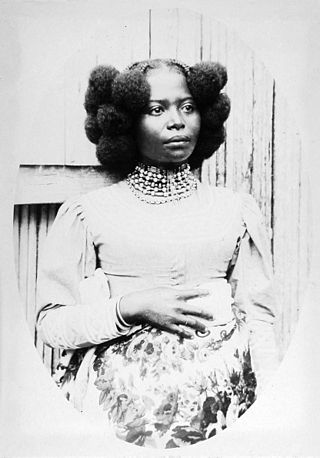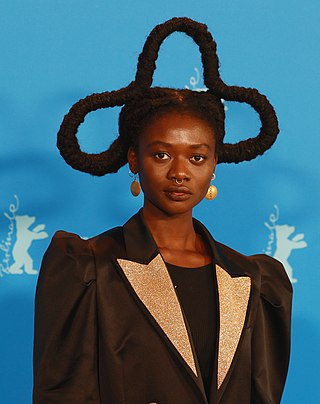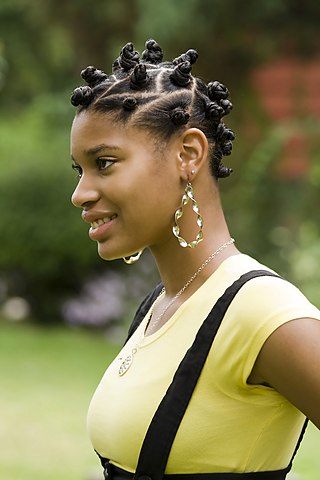Related Research Articles

A hairstyle, hairdo, haircut or coiffure refers to the styling of hair, usually on the human head but sometimes on the face or body. The fashioning of hair can be considered an aspect of personal grooming, fashion, and cosmetics, although practical, cultural, and popular considerations also influence some hairstyles.

Dreadlocks, also known as dreads or locs, are rope-like strands of hair formed by matting which is done by not combing the hair and allowing the hair to mat naturally or by twisting hair and over time the twisted hair will form into matted locs.
A braid is a complex structure or pattern formed by interlacing three or more strands of flexible material such as textile yarns, wire, or hair. The simplest and most common version is a flat, solid, three-stranded structure. More complex patterns can be constructed from an arbitrary number of strands to create a wider range of structures. The structure is usually long and narrow with each component strand functionally equivalent in zigzagging forward through the overlapping mass of the others. It can be compared with the process of weaving, which usually involves two separate perpendicular groups of strands.

The afro is a hair style created by combing out natural growth of afro-textured hair, or specifically styled with chemical curling products by individuals with naturally curly or straight hair. The hairstyle can be created by combing the hair away from the scalp, dispersing a distinctive curl pattern, and forming the hair into a rounded shape, much like a cloud or puff ball.

Cornrows are a style of braids in which the hair is braided very close to the scalp, using an underhand, upward motion to make a continuous, raised row. Cornrows are often done in simple, straight lines, as the term implies, but they can also be styled in elaborate geometric or curvilinear designs.
Artificial hair integrations, more commonly known as hair extensions, hair weaves, and fake hair add length and fullness to human hair. Hair extensions are usually clipped, glued, or sewn on natural hair by incorporating additional human or synthetic hair. These methods include tape-in extensions, clip-in or clip-on extensions, micro/nano rings, fusion method, weaving method, and wigs.
Black is beautiful is a cultural movement that was started in the United States in the 1960s by African Americans. It later spread beyond the United States, most prominently in the writings of the Black Consciousness Movement of Steve Biko in South Africa. Black is beautiful got its roots from the Négritude movement of the 1930s. Negritude argued for the importance of a Pan-African racial identity among people of African descent worldwide.

Kinky hair, also known as afro-textured hair, is a human hair texture prevalent in the indigenous populations of many regions with hot climates, mainly sub-Saharan Africa, Melanesia, and Australia. Each strand of this hair type grows in a tiny, angle-like helix shape. The overall effect is such that, contrasted with straight hair, wavy hair, or curly hair, kinky hair appears denser.

Synthetic dreads, also called dread extensions, dread falls, and cyberlocks, are interlocked coils of synthetic hair, mostly kanekalon, that give the look and feel of natural dreadlocks without the commitment or maintenance. They are mainly worn as a fashion statement for the subculture of cybergoth.

African-American hair or Black hair refers to hair types, textures, and styles that are linked to African-American culture, often drawing inspiration from African hair culture. It plays a major role in the identity and politics of Black culture in the United States and across the diaspora. African-American hair often has a kinky hairy texture, appearing tightly coiled and packed. Black hair has a complex history, culture, and cultural impact, including its relationship with racism.

The national costume of Indonesia is the national attire that represents the Republic of Indonesia. It is derived from Indonesian culture and Indonesian traditional textile traditions. Today the most widely recognized Indonesian national attires include batik and kebaya, although originally those attires mainly belong within the island of Java and Bali, most prominently within Javanese, Sundanese and Balinese culture. Since Java has been the political and population center of Indonesia, folk attire from the island has become elevated into national status.
Discrimination based on hair texture, also known as textureism, is a form of social injustice, where afro-textured hair or coarse hair types are viewed negatively, often perceived as "unprofessional", "unattractive", or "unclean".
The natural hair movement is a movement which aims to encourage people of African descent to embrace their natural, afro-textured hair; especially in the workplace. It originated in the United States during the 1960s, and resurged in popularity in the 2000s.

Box braids are a type of hair-braiding style that is predominantly popular among African people and the African diaspora. This type of hairstyle is a "protective style" and is "boxy", consisting of square-shaped hair divisions. Box braids are generally installed by using synthetic hair which helps to add thickness as well as helping the natural hair that is in the braid. Because they are not attached to the scalp like other similar styles such as cornrows, box braids can be styled in a number of different ways. The installation process of box braids can be lengthy, but once installed they can last for six to eight weeks. They are known for being easy to maintain.

Braids are a complex hairstyle formed by interlacing three or more strands of hair. Braiding has been used to style and ornament human and animal hair for thousands of years in various cultures around the world.

Laetitia Ky is a feminist artist from Ivory Coast who creates sculptures from her hair, and is seen by many as a figurehead in the natural hair movement.

A protective hairstyle is a term predominantly used to describe hairstyles suitable for Afro-textured hair. These hairstyles are designed to minimize manipulation and exposure of the hair to environmental elements. Factors such as extreme temperatures, humidity, and precipitation can adversely affect hair health. Protective hairstyles are beneficial in mitigating these effects by keeping the hair tucked away and reducing its exposure to potentially damaging conditions.

Pamela L. Ferrell is an American entrepreneur, pioneer and advocate in the natural haircare field. She is best known for the pivotal role she played in assisting the United States (U.S.) Army and Navy with their review of hairstyle policies and regulations. She is the first known and documented African-American to help shape hair policies within the United States Armed Forces.

Rogers v. American Airlines was a 1981 legal case decided by the United States District Court for the Southern District of New York involving plaintiff Renee Rogers, a Black woman who brought charges against her employer, American Airlines, for both sex and race discrimination after she was dissuaded from wearing her hair in cornrows due to the airline's employee grooming policy. Rogers believed that this hair policy was a violation of her Title VII rights.

Yoruba women’s clothing is the traditional attire worn by women of the Yoruba ethnic group in parts of Nigeria, Benin and Togo in a region called Yorubaland. The clothing reflects the rich culture, history and aesthetic preferences of the Yoruba people.
References
- ↑ Mensah, Charlotte (29 October 2020). Good Hair: The Essential Guide to Afro, Textured and Curly Hair. Penguin UK. ISBN 978-0-241-98817-6.
- ↑ Dazed (12 May 2020). "Is a traditional African hairstyle really a 'coronavirus trend'?". Dazed. Retrieved 30 December 2023.
- ↑ "Naa Oyoo Quartey". ganyobi1.rssing.com. Retrieved 30 December 2023.
- ↑ HQ, CIAFE (9 December 2022). "Understanding African Hair Threading - Explainer". CIAFE. Retrieved 30 December 2023.
- ↑ Akorli, Rudith (2014). "Reveal". Rochester Institute of Technology– via Academia.edu.
- ↑ Livara (7 February 2023). "Black History Month: The Rich History of Our African Hair - Livara Natural Organics" . Retrieved 30 December 2023.
- ↑ "AFRICAN THREADING: Heatless Natural Hair Blow-out". Organic Beauty Essence. Retrieved 30 December 2023.
- ↑ MENSAH, CHARLOTTE (February 2019). "Celebrating The Art Form Of African Hair Threading". www.refinery29.com. Retrieved 24 January 2024.
- ↑ "Best Type Of Thread To Use For African Hair Threading In 2024 | This Is BEAUTY MART". 13 October 2023. Retrieved 24 January 2024.
- ↑ "African Threading for Hair Growth, Benefits and Uses". Black Natural and Proud Sistas. 9 January 2020. Retrieved 24 January 2024.
- ↑ Dugger, Medina. "Chroma: An Ode to J.D. 'Okhai Ojeikere - Photographs and text by Medina Dugger". LensCulture. Retrieved 24 January 2024.